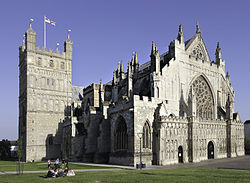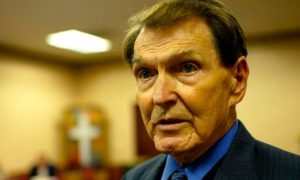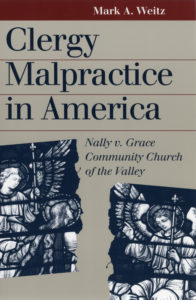 Recently in the Church Times there was a report about a Visitation by the Bishop of Exeter to his Cathedral. The full text of this Visitation report, as is common these days, was released on to the Internet. This meant that anyone, like myself, who is interested in issues of power in an ecclesiastical setting could study the detail of what was written about the various problems at Exeter. Also we have the directions given out to the various parties by the Bishop, Robert Atwell. This Visitation, although addressing the situation of one particular institution raises a number of important points in the way the Church finds it hard to deal with power and its management. Also it is an insight into some of the issues that have arisen at cathedrals since the passing of the Cathedrals Measure in 1999. This set out for all English cathedrals a common pattern of governance and management in respect of their affairs.
Recently in the Church Times there was a report about a Visitation by the Bishop of Exeter to his Cathedral. The full text of this Visitation report, as is common these days, was released on to the Internet. This meant that anyone, like myself, who is interested in issues of power in an ecclesiastical setting could study the detail of what was written about the various problems at Exeter. Also we have the directions given out to the various parties by the Bishop, Robert Atwell. This Visitation, although addressing the situation of one particular institution raises a number of important points in the way the Church finds it hard to deal with power and its management. Also it is an insight into some of the issues that have arisen at cathedrals since the passing of the Cathedrals Measure in 1999. This set out for all English cathedrals a common pattern of governance and management in respect of their affairs.
Before 1999 English cathedrals were individually governed by constitutions and statutes which, in many cases, were formulated in the Middle Ages, or if not then, in the aftermath of the Reformation. The Measure of 1999 was an attempt to bring these institutions into the modern age, especially in respect of their oversight, leadership and accountability. Among the main changes that were introduced for all cathedrals was the setting up of Councils to which Chapters would be accountable and which the diocesan bishop had the right to attend (though not to vote). At the same time the appointment of an administrator or Chapter Clerk became a legal requirement along with the creation of a statutory committee to oversee its finance. The Dean and residentiary canons and lay Chapter members remain legally responsible for the strategic direction and day to day implementation of the Cathedral’s mission, including teaching, preaching, worship, music, finance, the care and development of the fabric, retail operations, visitor ministry and outreach. This obviously entails maintaining good relationships with a small (sometimes not so small) army of paid staff as well as the many volunteers who make the day-to-day running of the institution possible. Together the Chapter, Council and College of Canons constitute the cathedral’s legal entity.
The role of the Bishop of the diocese with his or her Cathedral has always been distinctive, especially where the cathedral is a medieval foundation (rather than a parish church that became a cathedral in modern times through the creation of new dioceses in the 19th and 20th centuries). Although every Cathedral will have a designated seat or cathedra for its diocesan bishop (the legal definition of a cathedral in the Measure is that it is “the seat of the Bishop and a centre of worship and mission”, his official liturgical presence in the building is carefully set out in the statutes which will require invitation by, or consent of, the Chapter. This is because the Bishop does not hold “ordinary” jurisdiction in a medieval cathedral in the same way as he or she does in a parish church. The Chapter thus operates in a way that is legally independent of the bishop’s direct jurisdiction, though when relationships are good, which they mostly are, the Bishop and Dean, and Bishop and Chapter, will maintain close contact to ensure that the strategic direction of the Cathedral is aligned to that of the Diocese. Indeed the Dean is the Bishop’s “senior priest”, colleague and critical friend, a relationship that is taken with great seriousness by the vast majority of bishops and their deans. This independence is, however, qualified by the fact that the bishop is in every case the legal “Visitor” of the Cathedral with the right of Visitation. What this means in practice is that when a major problem arises, the bishop can choose Visitors to enter the cathedral and inquire about the problems on his behalf. On the basis of these enquiries, the bishop will issue what is known as a Charge. This is not dissimilar to a judge publishing a judgement after a complicated court hearing.
Without at this point focusing on the problems that are currently being encountered in Exeter, we can note that our English cathedrals operate with an extremely complicated and possibly unwieldy structure of governance in place. In practice each cathedral has three centres of power. By statute, the Chapter is charged with the leadership and governance of the Cathedral and the direction of its mission. But again by statute, the Council legally holds the oversight and accountability of the Chapter. Then informally, a good deal of power and influence may be held by the lay administrator, especially in respect of lay staff. Over all three of these stands a fourth focus of power in the form of the diocesan bishop as Visitor. If things go wrong in this delicate quadrangle, resolution can be extremely difficult to achieve. Even when things are going well, one can imagine that it is demanding for all the parties concerned, especially the Dean who stands at the intersection of all these foci of authority and power. If trust is at a low ebb, it does not take very much to disturb the delicate mechanisms of checks and balances. The exercise of power in any institution is always a tricky balancing act and the slightest hint of egotism or narcissistic behaviour by any of the parties will easily throw the whole institution into dysfunction or collapse.
The situation at Exeter as revealed by the Visitation and the Bishop’s Charge suggests that there has been a breakdown in two particular directions. In the first place the Dean, Jonathan Draper, has become distanced from some of his senior staff. The details of this estrangement are not revealed but the problem is sufficiently serious for lay-people to detect a difficult atmosphere during the conduct of worship on Sunday mornings. There is also a suggestion that the Dean no longer has the confidence of many of the other staff working at the cathedral. There seems to be poor communication and the impression is given that the Dean is neither concerned for the detail of the running of the cathedral nor working collaboratively. It is recognised by the report that the Dean is a man of considerable ability; he preaches well and has a vision for the future. Such gifts however are somewhat neutralised by a failure to foster a culture where everyone is able to work together successfully with high morale.
The Bishop of Exeter’s Charge to Exeter Cathedral is an important document as it lays out, even if indirectly, how gifted a Dean has to be on a human level, to manage the expectations placed on him in the years following the implementation of the Cathedrals Measure. No longer is the Dean able to exercise autonomous control (in the so-called “Old Foundations” like Exeter, Salisbury, York and St Paul’s this was never the case to begin with). He or she has to operate within the parameters set by the other legal stakeholders: the Chapter itself (the Measure of 1999 abolished the time-honoured phrase “Dean and Chapter”), the Cathedral Council and the Bishop-as-Visitor. Finding a person who is a good team player, who is able to negotiate considerable the tensions of human fragility as well as articulate and put into practice a vision for the institution and building and its public role in a diocese and in wider society will never be easy. To make life even more complicated, I sensed between the lines of the Charge that at Exeter there existed a failure of trust between the Bishop and the Dean. Although the Dean is directed by the Bishop to put in place various structures to resolve issues, his actual name is never mentioned. This absence of a name suggested that the Bishop had objectified all the problems at his Cathedral. There was no hint that he, the Bishop, might at an early stage have built strong informal relationships with the clergy at the Cathedral that could have neutralised some of the tensions. No doubt the Episcopal Visitors did a good job and identified all the issues at Exeter. They included Baroness Butler Sloss, whose wisdom was put to good effect in the Archbishop’s Visitation to the Diocese of Chichester.
The Exeter Cathedral Charge by its Bishop is, to conclude, a fascinating document. It uncovers various layers of unhealthy power dynamics within that institution which, no doubt, will be studied by other cathedrals. But a variety of uncomfortable questions are thrown up by the reading it. The Bishop, in what sounds like a very old fashioned language of authority, ‘directs’ the various stakeholders of the cathedral to do certain things to resolve managerial, financial and leadership issues. The use of this word ‘direct’ sounds peculiarly inappropriate in the 21st century. Can problems of poor communication and broken relationships be solved by an episcopal direction to work with facilitators and similar means? There is something almost feudal about being told to sort out problems in this way. All I know is that if someone set over me directed me to behave in a particular way or to put in place a particular structure, I would feel suffocated and put upon in this relationship. Surely there are better ways for a bishop to speak to members of his Cathedral Chapter. Are we perhaps seeing in the document a mediaeval use of power trying to assert itself in the 21st century? From where I am sitting this simply does not seem to work. The document is thus perhaps a testimony to the way that the church still does not grasp how power actually works in its institutional life. Such a failing, as I try to remind my readers constantly in this blog, is very serious. If we did have better insights in the way power functions in a church, whether at congregational or cathedral level, then we would have a better chance of stopping it becoming festering and abusive. When power is not well managed, institutions wither and even die. The next months and years at Exeter Cathedral are very likely to be troubled and unhappy. One wonders whether the content and style of this Visitation and Charge have done anything substantial to lessen this likely outcome.
I am grateful to Michael Sadgrove for helping me with some of the technical aspects of this blog post





